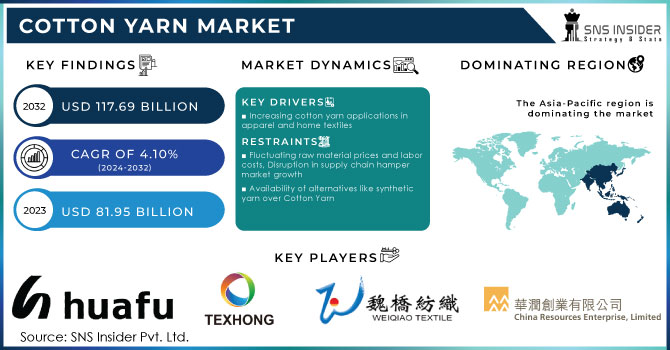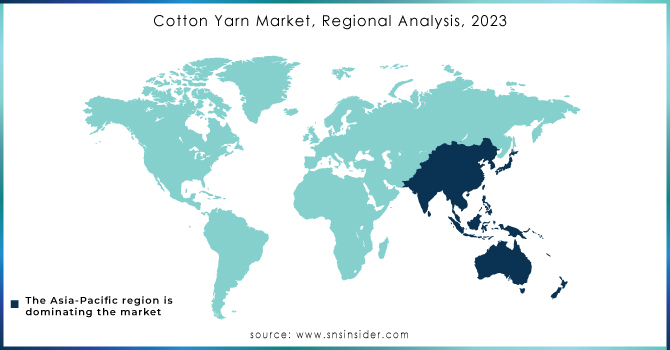Cotton Yarn Market Report Scope & Overview

Get E-PDF Sample Report on Cotton Yarn Market - Request Sample Report
The Cotton Yarn Market size was valued at USD 81.95 Billion in 2023 and is expected to reach USD 117.69 Billion by 2032 and grow at a CAGR of 4.10% over the forecast period of 2024-2032.
The cotton yarn market has experienced steady growth due to increasing demand from the textile and apparel industries. Cotton yarn, known for its comfort, breathability, and softness, remains a preferred material in the production of fabrics for clothing, home textiles, and industrial applications. The market is driven by the expanding global textile manufacturing sector, fueled by rising consumer preferences for sustainable and natural fabrics.
Key trends influencing the cotton yarn market include innovations in spinning technologies, which enhance the quality and efficiency of cotton yarn prodution. Additionally, the growing focus on eco-friendly and organic cotton yarn, as consumers become more environmentally conscious, has significantly impacted the market. Many manufacturers are adopting organic cotton production processes to cater to the demand for sustainable materials. Moreover, automation and digitization are being increasingly adopted in cotton yarn production facilities to improve productivity and reduce operational costs.
The rise of e-commerce platforms and online retail for textiles has also expanded the market's reach, providing more direct channels for manufacturers and consumers to connect. This has led to an increase in demand for a wide range of cotton yarn varieties, from fine yarns used in high-quality apparel to coarser yarns used in industrial fabrics. Furthermore, the growing awareness regarding the advantages of cotton over synthetic fibers in terms of comfort, breathability, and natural origins is propelling market growth.
MARKET DYNAMICS
DRIVERS
- The increasing demand for textiles, driven by rising disposable incomes and changing fashion trends, directly boosts the cotton yarn market, as it is a key raw material in fabric production
The increasing demand for textiles is a key driver of the cotton yarn market. As global disposable incomes rise, consumers have more spending power, leading to greater demand for textiles, particularly clothing. Changing fashion trends also play a crucial role, as consumers seek new and diverse fabrics to suit their tastes. Cotton yarn, being a fundamental raw material in fabric production, is directly impacted by this demand. It is used extensively in manufacturing a variety of textile products, including apparel, home textiles, and industrial fabrics. As the textile industry expands globally, particularly in emerging economies, the need for cotton yarn grows in tandem. This trend is further supported by the increasing preference for natural and sustainable fibers like cotton, making it a staple in textile production. Thus, the rising demand for textiles, driven by economic growth and shifting consumer preferences, significantly fuels the cotton yarn market's growth.
RESTRAINT
- Fluctuating cotton prices, driven by climate change, crop diseases, and geopolitical issues, create uncertainty in raw material costs, challenging cotton yarn manufacturers to maintain stable profit margins.
Fluctuating cotton prices significantly impact the cotton yarn market, as they are influenced by various external factors, including climate change, crop diseases, and geopolitical issues. Climate change can lead to unpredictable weather patterns, affecting cotton production and yields. Crop diseases, such as boll weevil infestations or fungal infections, can also reduce cotton availability, causing price hikes. Additionally, geopolitical tensions and trade restrictions in major cotton-producing countries can disrupt supply chains and lead to price volatility. These fluctuations create uncertainties in raw material costs, making it difficult for cotton yarn manufacturers to plan and maintain stable profit margins. As raw cotton is the primary input for yarn production, any significant price increase or decrease directly impacts production costs, which may be passed on to consumers or result in tighter margins for manufacturers. This volatility can make it challenging for businesses to remain competitive and maintain consistent pricing strategies.
MARKET SEGMENTATION
By Type
The Carded Yarn segment dominated with the market share over 48% in 2023, due to its extensive use in various applications, such as lower-cost fabrics, home textiles, and industrial textiles. Its affordability in production makes it a popular choice for cost-sensitive sectors. Carded yarn’s relatively lower production cost compared to combed yarn allows manufacturers to meet the demands of budget-conscious consumers while ensuring versatility across different textile products. As a result, this segment remains dominant, offering a balance between performance and cost, which has cemented its position in the global cotton yarn industry.
By Application
The apparel segment dominated with the market share over 64% in 2023. Cotton yarn is highly sought after for its comfort, breathability, and natural appeal, making it a preferred choice for clothing and fashion products. As a result, the apparel industry continues to be the largest end-use segment, driving substantial demand for cotton yarn. The versatile and sustainable nature of cotton further strengthens its position in the market, especially as consumers increasingly seek eco-friendly fabrics. This longstanding demand ensures the apparel sector maintains its leading role, significantly contributing to the overall revenue of the cotton yarn market.
KEY REGIONAL ANALYSIS
The Asia-Pacific region dominated with the market share over 38% in 2023, due to its robust textile manufacturing capabilities. Countries like China, India are key players, accounting for a significant share of global cotton yarn production and consumption. These nations benefit from well-established cotton farming practices, a large labor force, and advanced textile infrastructure. Additionally, the region has a strong export network, making it a dominant supplier of cotton yarn worldwide. The growing demand for cotton yarn in various industries, including apparel, home textiles, and industrial applications, further solidifies Asia-Pacific’s leading position in the global market.
North America is experiencing rapid growth in the cotton yarn market due to rising consumer demand for sustainable and high-quality cotton yarn in various applications, particularly in apparel and home textiles. This growth is further fueled by the region's emphasis on eco-friendly production methods and the preference for ethically sourced materials. Additionally, there is a notable shift towards domestic production, driven by advancements in textile manufacturing technologies and increased focus on reducing supply chain dependency.

Get Customized Report as Per Your Business Requirement - Request For Customized Report
Some of the major key players in the Cotton Yarn Market
- Huafu, (Cotton yarn, Polyester yarn)
- Huamao (Cotton yarn, Blended yarn)
- Texhong (Cotton yarn, Spun yarn)
- Weiqiao Textile (Cotton yarn, Dyeing yarn)
- Lutai Textile (Cotton yarn, Polyester-cotton blended yarn)
- Henan Xinye Textile (Cotton yarn, Spinning yarn)
- BROS (Cotton yarn, Blended yarn)
- China Resources (Cotton yarn, Cotton/polyester blended yarn)
- Nishant Mills (Cotton yarn, Carded yarn)
- Aarti International (Cotton yarn, Ring spun yarn)
- Vardhman Textiles (Cotton yarn, Open end yarn)
- Gokaldas Exports (Cotton yarn, Combed yarn)
- Shandong Ruyi Technology Group (Cotton yarn, Fancy yarn)
- Alok Industries (Cotton yarn, Stretch yarn)
- Sutlej Textiles and Industries (Cotton yarn, Organic cotton yarn)
- Coats Group (Cotton yarn, Industrial yarn)
- Zhangjiagang Hengli Textile (Cotton yarn, Carded cotton yarn)
- Jiangsu Lianfa Textile (Cotton yarn, Slub yarn)
- KPR Mill (Cotton yarn, Carded and combed yarn)
- Suryalakshmi Cotton Mills (Cotton yarn, Dyed yarn)
Suppliers for (Cotton yarn, specialized yarns for weaving and knitting) on Cotton Yarn Market
- Arvind Limited
- Vardhman Textiles Ltd.
- Coats Group
- Loyal Textile Mills Ltd.
- Nahar Spinning Mills Ltd.
- Sri KPR Industries
- Hercules Yarn
- Rieter
- Sintex Industries Ltd.
- The South India Textile Research Association (SITRA)
RECENT DEVELOPMENTS
In 8 August 2024: Jiangsu Lianfa Textile to invest USD 500 million in Egypt
Jiangsu Lianfa Textile will build a $500 million textile facility in Egypt, focusing on spinning, weaving, and dyeing, with 90% of production aimed for export. The project highlights growing Chinese interest in Egypt's strategic location and trade agreements.
| Report Attributes | Details |
| Market Size in 2023 | USD 81.95 Billion |
| Market Size by 2032 | USD 117.69 Billion |
| CAGR | CAGR of 4.10% From 2024 to 2032 |
| Base Year | 2023 |
| Forecast Period | 2024-2032 |
| Historical Data | 2020-2022 |
| Report Scope & Coverage | Market Size, Segments Analysis, Competitive Landscape, Regional Analysis, DROC & SWOT Analysis, Forecast Outlook |
| Key Segments | • By type (Carded Yarn, Combed Yarn, Others) • By application (Apparel, Textiles, Others) |
| Regional Analysis/Coverage | North America (US, Canada, Mexico), Europe (Eastern Europe [Poland, Romania, Hungary, Turkey, Rest of Eastern Europe] Western Europe] Germany, France, UK, Italy, Spain, Netherlands, Switzerland, Austria, Rest of Western Europe]), Asia Pacific (China, India, Japan, South Korea, Vietnam, Singapore, Australia, Rest of Asia Pacific), Middle East & Africa (Middle East [UAE, Egypt, Saudi Arabia, Qatar, Rest of Middle East], Africa [Nigeria, South Africa, Rest of Africa], Latin America (Brazil, Argentina, Colombia, Rest of Latin America) |
| Company Profiles | Huafu, Huamao, Texhong, Weiqiao Textile, Lutai Textile, Henan Xinye Textile, BROS, China Resources, Nishant Mills, Aarti International, Vardhman Textiles, Gokaldas Exports, Shandong Ruyi Technology Group, Alok Industries, Sutlej Textiles and Industries, Coats Group, Zhangjiagang Hengli Textile, Jiangsu Lianfa Textile, KPR Mill, Suryalakshmi Cotton Mills. |
| Key Drivers | • The increasing demand for textiles, driven by rising disposable incomes and changing fashion trends, directly boosts the cotton yarn market, as it is a key raw material in fabric production |
| RESTRAINTS | • Fluctuating cotton prices, driven by climate change, crop diseases, and geopolitical issues, create uncertainty in raw material costs, challenging cotton yarn manufacturers to maintain stable profit margins. |

